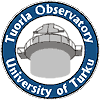|
The Väisälä
Institute for Space Physics and Astronomy (VISPA)
was formed at the University of Turku in 2001, by joining
the Space Research
Laboratory (SRL) in the Department of Physics and
Tuorla Obervatory. The two research units forming VISPA
retained their previous positions in the university
administration, Tuorla as an independent research
institute, and SRL as one of the six laboratories of the
Department of Physics.
This year (2002) was the 50th anniversary year for
Tuorla
Observatory. It was in 1952 that Academician
Yrjö Väisälä moved the Turku
University astronomical observatory from Iso-Heikkilä
to Tuorla. The observatory had operated at
Iso-Heikkilä for 30 years, but the town had grown
around it, so it was not possible to observe there any
more. At Tuorla the skies were still dark, even though it
is only 15 km from Turku.
To celebrate the 50th anniversary the observatory
organised an international meeting "High Energy Blazar
Astronomy" at Tuorla in 17-21 June. The meeting brought
together 70 astronomers around the world to discuss the
current status of blazar research. Emphasis in this
meeting was on the highest energies.
|
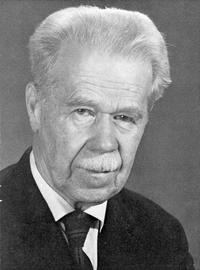 Yrjö Väisälä (1891-1971), for whom
VISPA is named.
Yrjö Väisälä (1891-1971), for whom
VISPA is named.
|
|
The year saw a lot of publicity received by Esko
Valtaoja, whose book Kotona maailmankaikkeudessa
(At home in the universe, Ursa 2001) won the
prestigious Finlandia award for non-fiction. The book,
discussing the possibility of life in the universe in a
witty style, was among the best-selling non-fiction
works of the year.
|
|
|
Telescopes and Instrumentation
|
|
The MAGIC telescope
In May 2002 Tuorla Observatory joined the MAGIC-telescope (Major Atmospheric
Gamma-ray Imaging Cherenkov telescope) collaboration as a full member. The
MAGIC collaboration includes 14 mostly European institutes who are constructing
a 17 metre Cherenkov-telescope on La Palma, Canary Islands, Spain. First light
is expected in summer/autumn 2003. This telescope will operate also in the energy
regime from 30 to 300 GeV, which has never before been explored. Because of
this new energy range and its much better sensitivity compared with other
Cherenkov telescopes, one expects MAGIC to detect and observe a large number of
new objects. So far only 6 blazars have been detected with energies above 500
GeV. The main contribution of Tuorla Observatory to the collaboration is the
use of the 60 cm optical KVA telescope on La Palma in connection with MAGIC
observations. This will allow simultaneous optical and gamma-ray observations.
This collaboration organises frequent meetings, last one was held in Wurzburg,
Germany. Students E. Lindfors and M. Pasanen together with researchers
A. Sillanpää and L. Takalo attended the meeting from
Tuorla. Discussions during the meeting included also preliminary observing
proposals for MAGIC.
The SATU telescope
M. Valtonen has spent much of the year at the St.Augustine-Tuorla telescope
(SATU) in Trinidad, in helping to get the telescope fully operational, with
assistance from H. Lehto. They have collaborated with S. Haque-Copilah and
other staff members of the Physics Department of the University of the West
Indies. The telescope is meant for monitoring blazars and cataclysmic
variables, especially in summer time and when the object is close to the Sun in
the sky. The geographical latitude of the observatory (11 degrees N) allows for
a year around coverage in the monitoring programmes, and minimises the loss of
data thanks to the short morning and evening twilight periods. This is
especially important during the upcoming campaign of the blazar OJ287. OJ287 is
expected to be in outburst from 15 May to 1 July in 2006 and again from 3 Sept
to 15 Oct in 2007. These are difficult periods to cover from more northern
observatories since the Sun passes close to OJ287 in the sky in early August.
|
|
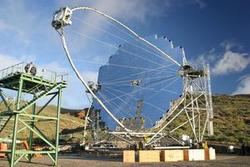
The MAGIC telescope at La Palma, slated
for "first-light" in late 2003. Tuorla is a full-member of the project,
and will be providing simultaneous optical data with the Royal Swedish Academy's
60 cm telescope sited nearby.
|
|
|
Dynamics
|
|
Chaos
Violent relaxation induced by dynamical chaos in gravitating systems is
proposed by J.-Q.Zheng, M. Valtonen, A. Chernin, S. Wiren and L. Ossipkov
(St.Petersburg). The basic physics of violent relaxation, which is a nonlinear
collective process in many-body gravitating systems, is treated in terms of
few-body chaos which is due to the excitation of a few high-amplitude
collective modes that involve a considerable portion of the mass of the
system. Dynamical chaos can induce and drive most effectively collective
relaxation processes that lead eventually from the initial Poincar\'e type
chaos to the final Maxwell-Boltzmann chaos, in astronomical gravitating systems
like globular clusters, galaxies and galaxy clusters.
Resonances and fractality in three-body chaotic dynamics are investigated by
H. Lehto, Heinämäki,
M. Valtonen, and A. Chernin with the use of homology mapping. A general
Newtonian three body problem is calculated to follow the evolution of about 1
700 000 bound three body systems which cover all the possible states where the
objects are initially at rest and have no angular momentum. The decay time
scales of the triple systems are determined and it is demonstrated that the
distribution of this parameter is fractal in appearance, in homology map. The
overall pattern is dominated by resonances.
The Contopoulos paradox is studied by A. Chernin, M. Valtonen,
P. Heinämäki and H. Lehto
with the focus on the temporal structure of evolving chaos in three-body
dynamics. The fact that the Lyapunov Characteristic Number, which is the major
quantitative measure of dynamical chaos, may be exactly zero for some clear
examples of chaotic behaviour is argued to point out generic limits of chaos in
a class of physical and astronomical systems.
Regions of stable motions are analysed around a periodic Eight-like orbit in
the general three-body problem by V. Orlov, A. Rubinov (St.Petersburg) and
A. Chernin. The fractal structure of the regions is recognised in
three-dimensional scans, and the fractal dimension is estimated to be between 2
and 3.
Three-body problem
M. Valtonen and H. Karttunen have worked on a text book "Three-body
Astrophysics" which is nearly completed. It gives the basic theories of the
General Three-body problem, using both statistical and perturbation approaches
at a level which is aimed at advanced undergraduate students. It also has a
thorough introduction to classical celestial mechanics, and a discussion of
applications to the scattering problems in the Solar System and in stellar
systems. It is hoped that the book will be in print in 2004.
In connection with the above work, M. Valtonen has derived several new
results in the General Three-body problem. The parabolic passage of a third
body past a circular binary was studied by using millions of numerical orbits
as well as a second order perturbation theory. The orbits were calculated by
the highly efficient Aarseth/Mikkola chain regularisation code which solves one
orbit per second in a personal computer. The solution is given in an analytic
form as a function of the masses, the relative orbit inclination, the
pericentre distance of the unperturbed orbit, and the phase angle of the binary
at the pericentre time. This result may be applied, among other things, to the
study of the long term stability of triple stars.
Together with A. Mylläri (Tuorla), V. Orlov and
Rubinov (St. Petersburg State University), M. Valtonen has studied the
statistical outcomes of three-body experiments in initially strongly bound
systems. A modified Monaghan/Heggie theory has been compared with 100 000
numerically calculated orbits. Special emphasis was given to escape directions
and to the spin relations after the system broke up into a binary and a third
escaping body. The previously known strong concentration of escapers in the
fundamental plane was confirmed, and an analytic expression for the
distribution as a function of the relative total angular momentum was
derived. This is relevant, for example, to black holes escaping from galactic
nuclei via the slingshot mechanism which is generally thought to be an
important consequence of multiple mergers of galaxies.
In collaboration with L.-Y. Zhou, Y.-S. Sun, J.-L. Zhou (Nanjing University)
and J.-Q. Zheng (Tuorla), M. Valtonen has studied what effect planet migration
has on Kuiper belt objects. The new feature of this study is the stochastic way
in which the migration should happen. Numerical integrations of small body
orbits show that stochasticity has a major effect on the resulting structure of
the Kuiper belt. Stochastic effects excite the orbital eccentricities and
inclinations in the non-resonant regions. They lead to a good match of orbital
distributions in the Kuiper belt, and possibly explain the sources of the
classical and scattered Kuiper belt objects.
The scattering theory in the General three-body problem has been applied to
the evolution of the population of stellar binaries in star clusters and in the
general Galactic field. It has been known since 1924 that the distribution of
binary semimajor-axes, or alternatively, of their periods is flat in a
logarithmic scale over the range of six orders of magnitude. This rather
surprising result, known as Öpik's law after its
discoverer or as scale free property of binary periods, has been without a
generally accepted explanation. M. Valtonen has shown that Heggie's hardening
law for binaries in clusters together with a distribution of observed star
cluster ages leads quite naturally to the Öpik's law
of Galactic binaries. Some initial form of scale free distribution may also be
justified among cluster binaries, using the statistical three-body theory, even
though it should be applicable only over a more limited range of periods.
In collaboration with S. Laine (Hubble Space Telescope Institute) and
J.-Q. Zheng (Tuorla), M. Valtonen has studied the dynamical structure of the
Coma cluster of galaxies under various assumptions of its mass
distribution. The starting point of these models is the double gravitational
well (massive binary galaxy) at the cluster centre. Such a model is strongly
supported by recent X-ray maps of the cluster centre as well as previous
studies of number density and radial velocity distributions around the two
dominant cluster members. The effect of the binary on the rest of the cluster
population depends on the length of time of the three-body action but generally
it causes some of the cluster members to escape. If we carry out mass estimates
of the cluster by standard methods and are unaware of this, the mass estimates
become too high by as much as a factor of two. This has significance in the
evaluation of the baryonic mass of the Universe since the Coma cluster is one
of the best studied and most quoted examples of clusters with a large amount of
dark matter.
Few-body problem
S. Mikkola has continued development of numerical integration methods for
the few-body problem and artificial satellite motion. This work has been
conducted in collaboration with P. Wiegert (Canada), P. Palmer (UK), S. Aarseth
(UK) and K. Innanen (Canada).
As a participant in an international team, Mikkola has investigated the
motion of interesting asteroids, such as 2002 AA29, which moves in a very tight
horseshoe orbit co-orbiting with the Earth.
Mikkola has supervised his graduate student
R. Brasser in studies of various aspects of the Solar
System and three-body dynamics. Among other things,
the role of secular resonances in the motions of
asteroids, co-orbital with the planets, has been
investigated both numerically and theoretically.
Solar sail orbital dynamics
V. Koblik has continued the study of solar sails. In previous studies, the
numerical simulations were used to examine the flight duration of some selected
sail missions and to investigate the evolution of the osculating elliptical
orbits. A point-like solar radiation pressure force model has been assumed
throughout and sail thermal estimations were applied in their simplest form
when the sail is taken as an ideal mirror. Both the planar (ecliptic) and the
three-dimensional transfer cases were examined with an upper limit on the
admissible sail temperature being considered as the basic restriction. The
"instantaneously" local-optimal control law of the sail orientation angle was
chosen in such a way that the rate of decrease of the orbital focal parameter
(semi-latus rectum) reached its maximal value. In the three-dimensional case,
the requirement of maximisation of the orbital plane rotation rate was added to
the model. The numerical results confirmed the great potential and unique
performances of a solar sail as a space thruster, especially in near-Sun
regions.
In 2002 the investigation, focused on planar (ecliptic) solar sailing toward
the Sun, was studied in combination with gravity-assisted (GA) flyby manoeuvres
at the Earth, Venus, and Mercury in sequence (multiplanet flybys). The orbit
dynamics for these cases were simulated under the assumption of a strong
thermal restriction on the sail surface temperature. Atmospheric correction was
taken into account. The numerical results, obtained in this study, confirmed
that only GA flybys of Venus change the orbit sufficiently, because Mercury is
too small. GA usually increases the orbital eccentricity and may be used for
transfers to destination orbits with large eccentricity.
The proposed studies have a considerable importance in both theoretical and
practical perspectives. From the theoretical perspective, the present project
aims at investigating a new class of trajectories for a space probe with an
ecological pure solar sail thrust with different control laws, at exploring
their principal properties and, in general, at expanding our knowledge about
the application of a solar sail as an unique thrust for a space probe. The
practical aspect of the project involves formulation of the specific
recommendations for possible use of the solar sail thrust for reaching various
types of orbits (trajectories) and for avoiding asteroid hazard for the
Earth.
|
|
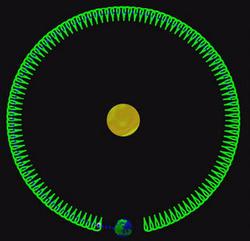
New Earth satellite - Image by Martin Connors, Paul
Chodas, Seppo Mikkola, Paul Wiegert, Christian Veillet
and Kimmo Innanen. Seppo Mikkola was part of an
international research team which discovered Earth's
third natural satellite, the asteroid 2002 AA29. The
asteroid is in a so-called hoseshoe orbit.
|
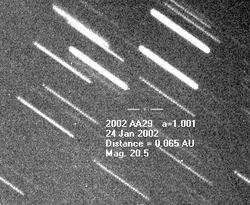
Discovery image of AA29, which was found in the LINEAR project. Source
Paul Wiegert.
|
|
|
Cosmology
|
|
A framework is suggested by A. Chernin in which the energy integrals of the
Friedmann cosmology are identified as genuine time-independent physical
characteristics for both vacuum and non-vacuum forms of cosmic energy. The
integrals are found to be numerically coincident within two orders of
magnitude. It is assumed that this coincidence reveals a symmetry that relates
vacuum to non-vacuum forms of cosmic energy at fundamental level. A simple
kinematic model of cosmological freeze out is used to examine how - at least,
in principle - the electroweak scale physics might explain the nature of the
symmetry between vacuum and non-vacuum cosmic energies and determine the value
of the energy integrals in terms of the fundamental energy scales. It is
demonstrated that the symmetry relation between vacuum and matter is basically
behind the observed phenomenon of parabolic or near parabolic cosmological
expansion with the flat or near flat three-dimensional space. A concept of
large macroscopic extra dimensions is also used to show that, in the case of
two extra dimensions, the Friedmann integrals are expressed in terms of the
fundamental electroweak energy M* ~ 1 TeV and the size R* ~ 10-3 cm
of extra dimensions. The correct value of the cosmic vacuum density proves to
be ~ R*-4.
A. Chernin, S. Starikova and D. Nagirner (St.Petersburg) found a new exact
explicit analytical solution for the growth rate of cosmological perturbations
against the cosmic vacuum background. In terms of the Newtonian mechanics, the
solution describes the evolution of weak linear protogalactic perturbations of
arbitrary shape and strong nonlinear perturbations in the Zeldovich flow of
plane symmetry. Perturbations develop under the action of gravitational
instability during the matter domination epoch, and the instability is
terminated when cosmic vacuum with its antigravity starts to dominate.
A. Chernin, Yu. Baryshev (St.Petersburg) and P. Teerikorpi addressed the
question: Why is the Hubble flow so quiet? Recent original observations in the
Local Volume are used together with other data to estimate the velocity
dispersion and matter nonuniformity in the Hubble local flow. A dynamical role
of cosmic vacuum is demonstrated to be dominant at distances 2-10 Mpc.
A. Chernin, I. Karachentsev (SAO), M. Valtonen, V. Dolgachev and
L. Domozhilova (Moscow) discussed a newly discovered phenomenon of the Hubble
very local (< 3 Mpc) flow on the basis of original data obtained with the
Hubble Space Telescope. A set of computer simulations is performed to trace the
trajectories of the flow galaxies back in time to the epoch of the formation of
the Local Group. It is found that the `initial conditions' of the flow were
drastically different from the linear velocity-distance relation and can
adequately be treated within the conjecture of The Little Bang developed
earlier by M. Valtonen et al. The simulations enable to recognise the major
trend of the flow evolution and to identify the anti-gravity of cosmic vacuum
as its driving force.
A. Chernin, D. Santiago and A. Silbergleit (Stanford) studied the interplay
between gravity and quintessence with the use of a set of new exact analytical
General Relativity solutions. It is found that cosmic vacuum and other forms of
dark energy with large negative pressure can produce both nonuniform static and
uniform nonstatic configuration where the antigravity of large negative
pressure plays a key role. In particular, a configuration is found with a
spatial singularity in which antigravity is infinitely strong. The work
attracted interest of the media; United Press International: "A team of
U.S. and Russian physicists has proposed important new solutions to Einstein's
famous gravity equations that suggest an entirely new object - a kind of
anti-black hole with infinitely strong anti-, or repulsive gravity".
A new kind of bias in the extragalactic Cepheid distance indicator was
identified by Teerikorpi, in collaboration with G. Paturel (Lyon). This may
explain the high value of H0 obtained by the HST key project, via biased
Cepheid distance values in their calibrations.
Using the cosmological Malmquist bias approach Teerikorpi showed that the
evidence for the separate class of the most luminous quasars does not depend on
the previously used cosmological model. In fact, the class appears best within
the presently favoured flat Lambda-model.
The reddenings caused by dark haloes around galaxies at intermediate
redshifts were studied by Teerikorpi. Radio-loud quasars with narrow absorption
line systems in their spectra were used as probes which now revealed for the
first time a clear correlation with the reddening and the number of absorption
systems. The effect corresponds to an intrinsic B-absorption of about 0.2 mag
in a dusty halo.
|
|
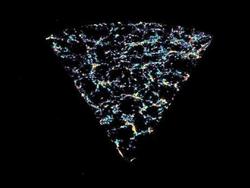
Simulation of large scale structure in the cosmos.
Credit, Pekka Heinämäki .
|
|
|
Blazars
|
|
Nilsson, Pursimo, Takalo and Sillanpää
have continued the blazar monitoring programme. They have
been monitoring the TeV BL Lacs using the 1.03 m
telescope at Tuorla and BVR-bands since autumn 2002. The
monitoring list includes 24 objects, selected from the
paper by Costamante & Ghisellini (A\&A, 384, 56, 2002),
and listed there as TeV sources or TeV candidate
sources. For many of the objects no previous monitoring
data can be found in the literature. The aim is to
characterise their variability and calibrate suitable
comparison stars in their vicinity to facilitate future
observations. These observations will provide "ground
work" for the MAGIC observations, since these objects
are possible targets for MAGIC.
Host galaxies of RGB BL Lacertae objects
BL Lacertae objects are a subgroup of active
galactic nuclei whose defining characteristics are
rapid flux variations over the whole electromagnetic
spectrum, high polarisation and almost total lack of
optical emission lines. Recent imaging studies have
shown that they reside almost exclusively in the nuclei
of luminous elliptical galaxies. There is also growing
evidence showing that they are actually low-luminosity
radio galaxies with a relativistic jet pointing nearly
towards us.
Studying the host galaxies can reveal important
clues to the origin of the activity of BL Lacertae
objects. For instance, the role of the galactic
environment in triggering and maintaining the nuclear
activity is still unknown. Since the properties of the
host galaxy do not depend on the orientation, they also
provide a way to study the parent population of BL
Lacs.
An imaging study of the RGB sample of BL Lacs was
carried out using the NOT. The RGB sample consists of
127 objects, all of which are X-ray and radio
emitters. During the study R-band images of 100 objects
wewre obtained and the host galaxies analysed using a
two-dimensional surface brightness fitting procedure
that separates the nuclear emission from the host
galaxy emission.
The host galaxy could be resolved in 62 cases and 37
new host galaxies were found. The hosts were found to
be luminous and large elliptical galaxies, whose basic
properties were very similar to those of inactive large
ellipticals. This indicates that the galactic
environment has little effect on the nuclear activity
and possibly every galaxy is capable of entering an
active phase at some stage during their
evolution. Contrary to some previous studies, not a
single clear example of a disk-dominated (i.e. spiral)
galaxy was found, although in a few cases the galaxies
clearly possessed embedded disk components. Also a
dozen optically weak nuclei were found supporting the
view that the BL Lac sequence continues to lower
luminosities than previously thought.
|
|
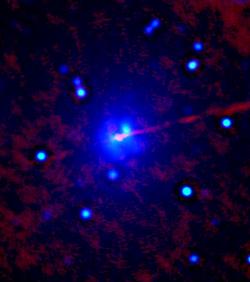
The nucleus of the radio galaxy Cygnus A. Red
denotes radio emission, blue optical
emission. Image by Kari Nilsson.
|
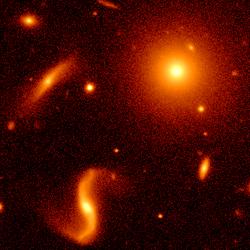
BL Lac object RGB1532+302 (the large elliptical
galaxy in the upper right corner). The host
galaxy of this nearby BL Lac (z = 0.064) has an
R-band luminosity of MR= -23.1 and effective
radius of 8.5 kpc, and it is surrounded by a
small group of spiral galaxies. The nucleus is
relatively weak, only ~ 5% of the total light
of the system comes from it. Credit: Kari
Nilsson.
|
|
|
Galaxies
|
|
Multi-component kinematics of the interstellar
medium around rich OB associations and triggering star
formation were studied by T. Lozinskaya (Moscow) and
A. Chernin with the use of the original observations of
the kinematics of the ISM around stellar associations
Cyg OB1, Cyg OB3. The data indicate that a rich OB
association can produce a set of expanding shells, and
the most massive of them is swept first by the stellar
winds. A gasdynamical model is worked out in which new
shells are produced due to the activity of WR stars and
supernova explosions. These secondary shells expand
rapidly and reach the first one. The collisions of the
shells provide favourable physical conditions for
triggering star formation, under which two basic
mechanisms - gravitational fragmentation and shock
compression - act together, enhancing each other.
V. Arkhipova, R. Noskova (Moscow) and A. Chernin
studied the phenomenon of Markarian activity in
interacting galaxies with the use of observational data
collected in an extended new edition of The Catalogue
of Interacting Galaxies (Vorontsov-Vel'yaminov et
al. 2001). The total number of interacting systems in
the catalogue is 2014, and about 10% of them are found
to be Markarian galaxies. The morphological and
dynamical systematics of the galaxies with interaction
induced activity are analysed and an interpretation of
the mechanism of nucleus activity is discussed on the
basis of the models proposed earlier by M. Valtonen and
G. Byrd.
Systematics in the location of brightest OB/HII
complexes in the major spiral arms of M 51 is discussed
by A.Chernin with the use of recently published far-UV
and Halpha data. It is demonstrated that the objects
occupy predominantly the areas around the corners of
the polygonal arm pattern of this galaxy. This is
treated as evidence that the physical conditions in
these specific areas can enhance massive star
formation. A possible gas dynamical explanation is
suggested for the phenomenon.
A. Chernin, V. Dolgachev and L. Domozhilova
developed two classes of computer models for wide
triplets of galaxies, one with individual galaxy dark
matter halos, and the other with the common dark matter
halo of a system as a whole. It is argued that X-ray
observations of these systems can provide a critical
test for the models and may also give new direct
cosmological constraints by establishing whether
ongoing clustering and hierarchical evolution are still
occurring on the mass scale of ~ 1013 Msun and space
scale ~ 1 Mpc or the systems on these scales are in the
quasi-steady-state virial equilibrium.
The Milky Way
A. Berdyugin and P. Teerikorpi continued the study
of interstellar polarisation at high galactic latitudes
from distant stars, using both the NOT telescope and
the KVA telescope at La Palma. An extended polarisation
map for the northern polar cap was interpreted as
showing structural features connected with the local
spiral arm.
Distances to galaxies in the extended local group
R. Rekola has obtained observations of dwarf
elliptical and irregular galaxies of the extended local
group using the NOT. Distances to the galaxies are
being determined via the surface brightness fluctuation
method (with H. Jerjen, Mount Stromlo
Observatory). Cepheid based distances for IC 342, a
large, starburst spiral galaxy, are being determined,
using observations with the NOT over a long baseline (5
years). Planetary nebulae are being used for a distance
determination to NGC 253 (using imaging data from the
ESO 3.6 metre). Mass determinations for a small set of
low surface brightness disk galaxies (with a view to
determining their dark matter content) are also
underway. This is part of a longer term programme to
assemble reliable masses and distances for the extended
local group galaxies with a view to simulating their
dynamics.
Groups of galaxies
P. Heinämäki finished his 2.5 year
post-doc period in Tartu Observatory in July
2002. During 2002 Heinämäki continued his
work with Las Campanas Loose Groups (LCLG), the mass
function of loose groups of galaxies and environmental
enhancement of loose groups around rich clusters of
galaxies. Owing to the poor number of determinations of
observational mass function available in the
literature, in particular for less massive systems, the
study of the mass function of loose groups of galaxies
is particularly relevant. Furthermore, the amplitude
and shape of the mass function reflect the underlying
cosmology and value of the normalisation parameter,
sigma8. In this work theoretical mass functions found
in numerical simulations (such as the Virgo Consortium
and own simulations) of structure evolution were
compared with the empirical mass function. Results
prefer a LambdaCDM model with Omegam = 0.3, OmegaLambda
= 0.7, h = 0.65 and sigma8 = 0.78-0.87. It
was found that the sample of LCLG is almost complete
for masses in the interval M ~ 1012 Msun to
1015 Msun.
The work has been continued with new deep galaxy
samples, Sloan Digital Sky Survey (SDSS), and our
intention among the ongoing analysis of the survey is
to compare SDSS with numerical simulations. The aim of
the simulations is to find a cosmological model
explaining the CMB anisotropies and observed large
scale-structure on scales of clusters of galaxies and
superclusters. Theoretical research and modelling in
this field is especially important now before the
PLANCK-satellite mission. We have joined the
PLANCK-satellite project and now are a member of a
working group of the large scale structure
simulations. During the year 2002 the collaboration
between Tartu and Tuorla observatories will be further
developed.
|
|
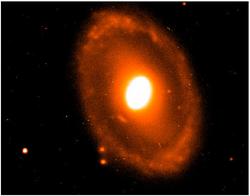
The spiral galaxy NGC 3081, imaged at the Nordic
Optical Telescope in B and I bands. Image by Seppo
Katajainen.
|

Part of the giant spiral galaxy IC 342. It lies
just beyond our own Local Group of Galaxies in
another group called Maffei Group or IC342/Maffei
Group. The image above is a combination of images
taken with BVRI filters (roughly blue, visual =
green, red, and infrared) by Rami Rekola and Kari
Nilsson at the Nordic Optical Telescope.
|
|
|
Very long baseline interferometry
|
|
Tuorla AGN VLBI group (Wiik, Savolainen and
Valtaoja) was granted a grand total of 102 hours of
observing time from the 10 VLBA telescopes for multi
frequency observations with the INTEGRAL gamma-ray
satellite. VLBA is commissioning its 3 mm capability
and therefore the success of routine monitoring
observations at this frequency can not yet be
guaranteed. However, the group agreed to observe also
at 3 mm which enables them to get the highest
resolution possible and interesting spectral
information of the sources at the millimetre
regime.
Also, a joint project with Metsähovi Radio
Observatory was started in order to study a selection
of gigahertz-peaked spectrum (GPS) radio sources with
extremely high peak frequencies. A total of 18 hours
of Very Long Baseline Array (VLBA) observing time was
used to produce high resolution radio images at six
frequencies of four selected sources.
Total flux density variations in 27 gamma-ray
blazars were compared with structural changes in
their parsec-scale jets using multi-epoch VLBA
observations at 22 and 43 GHz together with data from
the Metsähovi quasar monitoring programme at 22
and 37 GHz. There is a clear connection between total
flux density outbursts and VLBI components emerging
into the jet. For essentially every new moving VLBI
component, there is a coincident total flux density
flare, with evolution similar to that of the
component. A large fraction of the shocks grow and
decay within the innermost few tenths of a
milliarcsecond and therefore we see them only as
"core flares" in the VLBI images.
High energy connection
Lähteenmäki and Valtaoja showed that
comparisons with the EGRET data indicate that
gamma-ray flares originate in the shocks located
downstream the jet rather than near the central
engine. At the time of an EGRET flare, the shock is
typically already over a parsec downstream from the
radio core, beyond the accretion disk and/or the
broad line region (BLR) photon fields. Thus, present
models for gamma-ray production are inadequate, since
they typically model the gamma-ray inverse Compton
flux as coming these external photon fields near the
central engine (Valtaoja et al. 2002).
Lindfors and Valtaoja modelled the inverse-Compton
flux produced in the shock by synchrotron
self-Compton (SSC) process. Also the quiet level
gamma-ray production was included in the model as a
constant jet component. The high frequency spectrum
cannot be explained exclusively by the first-order
SSC-process (Lindfors, M.Sc. thesis, completed in
March 2003) and further modelling is to be done.
|
|
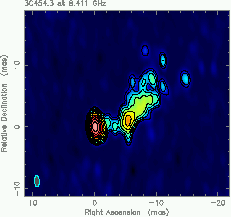
VLBA image of 3C454.3 at 4 cm. This source was used
as a calibrator in the Tuorla-Metsähovi
Gigahertz Peaked Spectrum (GPS) project. Although
only 10 minutes of the granted 18 hours of total
observing time was spent for this particular source,
it was possible to make this rather high quality
image during the preliminary inspection of the
dataset. Credit: Kaj Wiik.
|
|
|
Dark Matter
|
|
C. Flynn has led the DARKSTAR project, ``Space Based
Studies of Dark Matter'', which is funded under the
ANTARES programme of the Academy of Finland and
TEKES. DARKSTAR achieved its first year of operation in
2002 and continues until early 2004. Flynn spent the
entire year 2002 on sabbatical leave (supported by the
Academy of Finland) at the Astrophysics and
Supercomputing Centre of Swinburne University of
Technology in Melbourne, Australia. Most of the time
was spent analysing dwarf stars measured by the the
European Space Agency's Hipparcos satellite. These
studies have lead to two spin-off results and are
presently being utilised to constrain the amount of
visible matter in the Galaxy's "normal"
(i.e. stellar) halo, for comparison with studies which
seek to constrain the luminosity of the "dark
halo". The second spin-off was the development of a
rather precise (indirect) means to measure the cosmic
production of helium since the Big Bang (see link at
right).
Dark Matter as black holes
J. Hänninen completed a numerical study of the
orbits of stars in the disk of the Galaxy affected by
massive black holes (dark matter) and giant molecular
clouds, for comparison with data also obtained from the
Hipparcos satellite. The conclusion was that black
holes remain a possible but unlikely source of disk
heating. These simulations are presently being extended
to the rest of the Galactic disk, not just the region
near the Sun.
Dark Matter as white dwarfs.
J. Holopainen is nearing the completion of his
master's thesis. He studied white dwarfs as dark matter
candidates, utilising recent space and ground based
data. He concluded that claims in the literature that
(part of) the dark matter have been found in the form
of ancient white dwarfs are premature. The dark matter
might be in this form, but there is little direct
evidence for it yet.
|
|
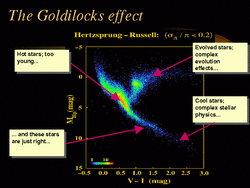
The Goldilocks effect.
K dwarf stars have been
used to measure the amount of Helium which has been produced via
fusion in stellar cores over cosmic time-scales.
|
|
|
Stars
|
|
H. Lehto and S. Katajainen have started a long term
campaign of monitoring cataclysmic variables (CVs)
using the Tuorla 70 cm (f2.5)
Schmidt-Vaisala
telescope equipped with an ST8 CCD. The CCD was
installed in November 2002, and since then CVs have
been observed.
Most of the CV-targets are magnetic cataclysmic
variables (mCVs), but also some dwarf novae, low-mass
X-ray binaries and symbiotic stars are included in the
sample. Due to the high latitude of the observatory
(60o 25') and long boreal nights, very long times
series can be obtained for intermediate polar (IP)
objects such as YY Dra, PQ Gem, V709 Cas, HT Cam, and
V405 Aur, and polars (i.e. AM Herculis stars) such as
GG Leo, EV UMa, RX J0719.2+6557. Also some new CV
candidates are being monitored.
This large amount of CV data helps in studying the
accretion geometry of each individual object and
variability from one orbital period to the next one and
over several nights.
A second aim of the programme is the (re)determination
of ill-known mCV ephemerides. Even many well studied
IP-systems have ephemerides which have been determined
a long time ago (10 years or so), and due to unaccuracy
of the original ephemerides, the orbital phases
calculated with those ephemeris will now include quite
large errors. By monitoring intensively objects in our
sample it is possible to calculate new and more
accurately determined ephemerides. The long monitoring
(in time scales of years) is able to reveal also if
some of the IPs have different spin rates than
originally was expected/calculated, because the
determination of spin period in IPs is not very
straightforward in some IPs due to different sideband
frequencies in their power spectrum. In this IP-project
we are collaborating with A. Norton et al. in the Open
University (Milton Keynes, UK)
In collaboration with the 40 cm SATU telescope at
the University of West Indies, Trinidad and Tobago, a
long term monitoring programme was begun to determine the
relative and absolute lengths of times the mCVs spend
in high and low states. The low states of mCV-systems
are poorly understood, because to cover well the
frequency of low states, monitoring in times scales of
years is needed. In the low states the light emitted in
the system is mainly from the cool secondary star (K or
M dwarf), and to understand how this secondary adjusts
thermally and refills its Roche lobe again, long term
monitoring is essential.
In 2002 Katajainen and Lehto have also studied
polars (AM Her star) V1309 Ori (MNRAS paper in press),
and GG Leo and EV UMa in collaboration with V. Piirola
(Tuorla), P. Hakala (Helsinki University), F. Scaltriti
(Turin) and G. Ramsay and M. Cropper (Mullard Space
Science Laboratory, Surrey, UK).
Lehto is also collaborating with
Dr. Laurits Leedjärv (Tartu Observatory, Estonia)
and V. Piirola (Tuorla) in studies of symbiotic
stars. They had one observing run at the NOT in
September 2002. The data is being analysed together
with previous data from the NOT. The scientific aim is
to find differences between the polarisation
characteristics of normal symbiotic stars and of
symbiotic stars that show high-velocity bipolar jets
and/or rapid light variations. The results will help to
constrain possible models of those peculiar symbiotic
stars. In a wider context it is aimed to contribute to
explanation of the jet ejection mechanism in general,
which is important also for understanding the AGN,
X-ray binaries etc.
Lehto and K. Mäkinen collaborate with
D. Johnsson (UK) in studies of the symbiotic star R
Aqr. The analysis of radio data is in progress with a
new jet model being formulated.
Lehto has in collaboration with E. Harlaftis
(National observatory of Athens, Greece) begun a work
to determine the spatial velocity distribution of X-ray
binaries with VLBI techniques. For these VLBI
observations a weekly monitoring campaign of about 30
sources started in Feb 2003 at the Nançay radio
telescope.
Andrei Berdyugin has continued the study of
interstellar polarisation at high galactic latitudes (b
> 70o) using the NOT and KVA on La Palma. With the new
data obtained in December with the Casleo telescope
(Argentina), now 3/4 of the area around South Galactic
Pole is covered. Polarisation observations of the
interacting early-type binaries with the KVA telescope
have been continued. Dependence of the polarisation
with the orbital phase has been detected and studied
for CX Dra and W Ser. CX Dra shows typical double-wave
pattern, which a small (0.1-0.2%) amplitude and shape
variation in the time scale of several
months. Polarisation variability in W Ser seems very
peculiar: it shows large (> 1%) amplitude with
unusually strong first harmonic of the orbital
period. Shape of the variability curve varies strongly
between different orbital cycles.
K dwarf stars
E. Kotoneva completed her Ph.D. thesis in January
2002. She computed the chemical composition of a large
uniform set of K dwarf stars in the European Space
Agency's Hipparcos satellite. The sample allows a very
precise measurement to be made of the distribution of
"heavy" elements (i.e. elements heavier than helium)
in a representative sample of stars near the Sun. This
is a major constraint on models of the evolution of
galaxies, and can be used indirectly to constrain the
density of matter (dark or otherwise) near the Sun.
Kotoneva has also used archival Hipparcos data to
demonstrate a simple and elegant relation between the
stellar position in the lower main sequence (stars less
massive than the Sun) and metallicity. The relationship
that was uncovered is really remarkably tight - so
clear and with such little scatter, that it leads to
metallicities for stars which are as accurate as doing
detailed spectroscopic work. The relationship was
predicted by stellar theory, but until now had not been
empirically demonstrated.
The technique leads to a new, independent distance
estimator. It is very useful because it can be applied
to existing Hubble Space Telescope data to constrain
the density of dwarf stars in the Galactic halo, with
very much more accurate distance measurements than all
work previously. This is a useful quantity for
comparison with studies of the dark matter content of
the Galactic halo in low mass stars.
|
|
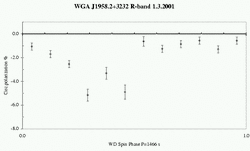
Circular polarisation
of the intermediate polar WGA J1958+3232 in the
R-band. Observed at the NOT on 1 March
2001. Credit: Seppo Katajainen.
(Click here for larger view).
|
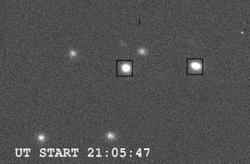
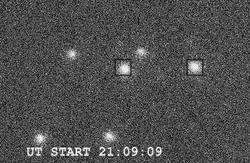
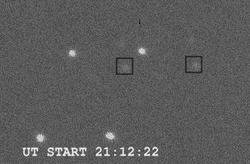
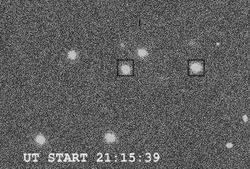
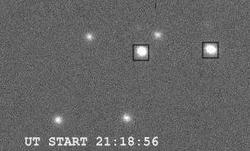
Time sequence of an AM Hercules type catalysmic
variable RX J0719.2+6557, taken at the Nordic
Optical Telescope in the B-band. Image Credit:
Seppo Katajainen and Harry Lehto.
|
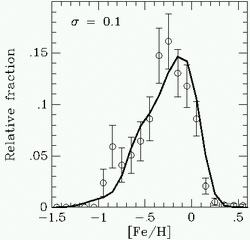
The K dwarf problem.
The plot shows data from our
survey of nearby K dwarfs, carefully selected in a
precise range by mass (approcimately 0.73 to 0.80
solar masses). The open circles show the relative
number of nearby stars with a metallicity [Fe/H], on a
logarithmic scale relative to the Sun. Most stars are
within a factor of a few of the Sun in their metal
content.
|
|
|
The Sun
|
|
Radio observations
The solar group at the Tuorla Observatory (Valtaoja, Pohjolainen, Riehokainen,
Khan) was originally established to analyse solar radio data from the
Metsähovi Radio Observatory (a Helsinki University of Technology facility)
and to make comparisons with other ground-based observations. Emphasis was
first on investigating quiet Sun features at centimetre and millimetre
wavelengths. A PhD thesis on radio bright regions at high solar latitudes was
being prepared by A. Riehokainen. The scientific interests of the group now
extend to solar flare and coronal mass ejection (CME) research, using X-ray and
EUV data together with imaging and spectral observations at various radio
wavelengths. The research subjects include, e.g., formation and signatures of
shock waves, flare and CME precursors, sources of homologous flaring, and
evolution of solar bright points. Most of the work was done in collaboration
with science teams abroad and in Finland. Dr. J.I. Khan, coming from the Yohkoh
satellite science team at ISAS, Japan, joined the group in August 2002, on a
one-year Academy of Finland visiting scientist fellowship.
The new Multibeam Solar Radio Telescope (MSRT), developed in co-operation with
the New Radio Telescope Technologies Lab. (Special Astrophysical
Observatory/St. Petersburg Technical University), was brought into use in
2002. The first observations at the 12 GHz test frequency were performed in
April, and MSRT observed two flares, on 10 April and 22 April 2002. The
antenna was also used for student exercises for the first time. The development
and building of the final multi-beam receiver was continued.
Enhanced temperature region at high and low solar latitudes
A. Riehokainen investigated enhanced temperature regions (ETR) at mm radio
wavelengths at Tuorla observatory during 1996-2003. Data for this study were
obtained from the Metsähovi Radio Telescope at 37 GHz and 87 GHz and also
from the Nobeayma Radioheliograph at 17 GHz. Radio data were compared with
different optical data such as SOHO/EIT/MDI, white light polar faculae,
CaII(k3) and Halpha spectral line observations.
Results obtained showed that ETRs are connected with two different types of
bright structures seen in CaII (k3) and Halpha spectral line observations. The
differential rotation of the Sun was obtained using the radio data. In
addition, existence of torsional oscillations at chromospheric and possible low
coronal height was established.
Connection between latitude time distribution of the ETRs at high solar
latitudes with the latitude time distribution of the polar faculae was
obtained. Association between ETRs and coronal holes is one of the main goals
in this study.
A 2 metre solar radio telescope has been built on the hill at Tuorla
Observatory. and first tests at 12 GHz were performed in April 2002. The
antenna was also used in student exercises: the lecturer S. Pohjolainen and
antenna constructor V. Khaikin explain here for the students how the system
works. The students were also lucky in observing a solar flare during the
exercise week!
Image of a CME taken by LASCO onboard SOHO. Perhaps one of the most spectacular
phenomena in our solar system is a solar protuberance. Protuberance is a common
name for many different types of solar events, most of which are invisible to
human eye.
Importance of the eruption history to the SEP acceleration
Production of solar energetic particles (SEPs) in the high-energy range,
10-100 MeV/nucleon, has been studied with the data of the electromagnetic-wave
and particle telescopes - EIT, LASCO, SUMER, and ERNE/HED, onboard
SOHO. Coronal mass ejections (CME) and near-surface phenomena, including
flares, were carefully studied for the time periods of the SEP events
registered with ERNE. A recent series of the investigations comprises the case
studies, a statistical analysis, and their perception. A SEP-producing eruption
typically consists of both flare and CME. Based on the multi-wavelength
studies, the importance of the eruption history to the production of solar
energetic particles has been emphasised. It often happens that in the
SEP-producing eruptions an impulsive-CME liftoff triggers in corona the local
flares and the global waves that start the particle acceleration, which
continues later at interplanetary shocks driven by CMEs. This finding suggests
that a forecasting of the high-energy particle fluxes at 1 AU requires the
broad-band data from a set of the spaceborne telescopes, like those on SOHO.
Discovery of the high-energy 3He-rich events
Energetic particle observations of the ERNE instrument onboard SOHO enable
measurements of 3He and 4He fluxes beyond 10 MeV/nucleon with a good
statistical resolution. The survey of the ERNE data for 1999-2000 has revealed
a new group of SEP events with 3He/4He > 0.2, which was apparently missed in
the previous observations.
In the event of 29 October 2000, a very strong 3He enhancement persists
over the high-energy range up to 50 MeV/nucleon. This is the first time that
the 3He/4He > 1 has been recorded at above 10 MeV/nucleon. The ERNE has enabled
the first ever measurement of the 3He energy spectrum in such an event. The
particle event was associated with an impulsive flare and interplanetary shock
wave. Type II radio burst was observed with the WAVES experiment onboard the
Wind spacecraft before and then simultaneously with the 3He-rich event
registered with ERNE. The analysis shows that the high-energy 3He-rich events
refer to the flare material reaccelerated at the flank of interplanetary
coronal mass ejection (CME). Onsets of the high-energy 3He-rich events were
observed in the far upstream regions, when the CME-driven shocks were at about
0.3 AU from the Sun. A numerical modelling of the 3He re-acceleration in oblique
shock driven by CME supports this interpretation.
The ERNE instrument on the SOHO mission was built at the Space Research
Laboratory section of VISPA. ERNE investigated the solar atmosphere by
detecting charged particles produced in various solar energy release processes
and undertaking the first systematic survey of Solar Energetic Particle (SEP)
isotopic abundance, with high sensitivity, high resolution sensors over a large
energy range. The SOHOmission has recently been nominated as one of the 30
success stories of the European Space Agency.
Collective Processes in Astrophysical Plasmas: Waves, Heating and Accelerated Particles (COPAP).
In 2002, VISPA researchers started a three-year COPAP project with the
Ruhr-Universitaet Bochum to study collective plasma phenomena relevant to the
solar corona and solar wind, as well as to the jets of active galactic nuclei
(AGN). The project is co-funded by the Academy of Finland and Deutscher
Akademischer Austauschdienst for travel and accomodation costs of researcher
exchange between the institutes.
The VISPA team participating in the project consists of four researches,
R. Vainio (team leader, SRL), E. Valtaoja (Tuorla), T. Laitinen (SRL) and
J. Virtanen (Tuorla). The team in Ruhr-Universitaet Bochum, lead by
R. Schlickeiser, likewise consists of four researchers participating in the
collaboration. Several researcher visits between the groups were conducted
during the first year of the project.
During the first year of the project, energetic particles transport and
acceleration in a wave-heated solar wind was studied. A numerical model capable
of computing the Alfvén-wave frequency spectrum consistently with the solar
wind plasma parameters resulting from wave heating was constructed and used to
study the acceleration of solar energetic particles in the self-consistently
modelled solar wind. The results gave important clues on both the mechanisms of
solar wind heating and the mechanisms of solar energetic particle
accleleration.
The AGN modelling within the project during the first year concentrated on
explaining gamma-rays up to TeV energies observed from several AGN. The model
developed for this employs hadronic emission from a dense blast wave moving
relativistically into the ambient interstellar medium. Research was done also
on electron acceleration in relativistic shock waves, studying especially the
effect of the structure of the shock wave on the acceleration process.
|
|
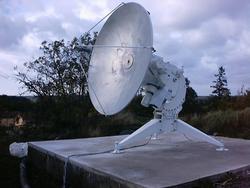
A 2 metre solar
radio telescope has been built on the hill at Tuorla
Observatory. and first tests at 12 GHz were
performed in April 2002. The antenna was also used
in student exercises: the lecturer S. Pohjolainen
and antenna constructor V. Khaikin explain here for
the students how the system works. The students were
also lucky in observing a solar flare during the
exercise week!
|
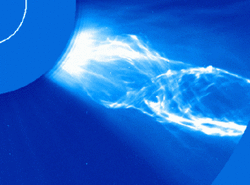
Image of a CME taken
by LASCO onboard SOHO. Perhaps one of the most
spectacular phenomena in our solar system is a
solar protuberance. Protuberance is a common name
for many different types of solar events, most of
which are invisible to human eye.
|
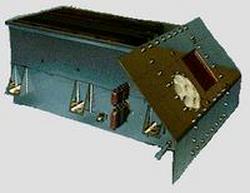
The ERNE
instrument on the SOHO
mission was built at the Space Research
Laboratory section of VISPA. ERNE
investigated the solar atmosphere by detecting
charged particles produced in various solar energy
release processes and undertaking the first
systematic survey of Solar Energetic Particle (SEP)
isotopic abundance, with high sensitivity, high
resolution sensors over a large energy range. The SOHO
mission has recently been nominated as one of the 30
success stories of the European Space Agency.
|
|
|
Earth's radiation environment and space weather
|
|
Energetic particle production in coronal mass ejection
(CME) driven shocks has been studied. Energetic particle
observations provide information on the lift-off and
coronal evolution of potentially geoeffective
interplanetary CMEs and thus are important for
understanding the global scenario of the
solar-terrestrial events. In order to obtain the
parameters essential for the coronal energetic particle
acceleration, a novel approach for modelling the solar
wind wave heating in parallel with the energetic
particles has been applied. As the essential processes
in both domains are related with the plasma wave power,
a scenario where both solar wind and energetic particle
models are consistent with observations, would produce
realistic parameters for coronal energetic particle
acceleration. A solar wind wave heating model has been
created and presented by T. Laitinen et al. The model was used to
study the coronal energetic particle acceleration and
interplanetary transport. The resulting interplanetary
transport was found to be orders of magnitude too slow,
compared to observations. However, the coronal energetic
particle acceleration was found efficient.
The energetic particle model was improved by
incorporating nonlinear wave-wave-interactions, which
reduce the wave power significantly. As a result, more
reasonable interplanetary transport was obtained,
already consistent with some observed energetic particle
events. The coronal energetic particle acceleration
efficiency, however, was somewhat reduced. Within the
model, the effect of CME-driven shock geometry and waves
generated by the energetic particle beams have also been
studied.
As the next step, wave-wave -interactions will be
implemented in the solar wind model. The model will
then be used for studying the energetic particle
acceleration and transport with different ambient solar
wind and CME characteristics.
The solar wind and energetic particle modelling has
been conducted in co-operation with
Ruhr-Universität Bochum under project COPAP, as
mentioned in the previous section.
Experimental investigation by using data from the
SOHO spacecraft and from international data archives
concentrated in deducing signatures from energetic
particle observations, which could be used for
predicting geoeffectivity of CMEs. Encouraging results
have been obtained based on the analysis of data from
the rising phase of the present solar cycle.
The feasibility of energetic particle observations
as an additional source of information in predicting
occurrence of geomagnetic storms has been
demonstrated. A proxy for the CME transit time from the
Sun to the Earth has been derived. Analyses have shown
that the time difference between the onsets of a
primary particle event and a particle shock peak in
interplanetary space correlates strongly with the
strength of the observed geomagnetic storm.
Analysis of experimental data from the declining
phase of the present solar cycle will be continued. The
solar wind/energetic particle model will be applied in
studying the energetic storm particles, observed as an
intensity peak (shock peak), when a CME is passing the
observing spacecraft. Using the solar wind and
energetic particle observations and models, a detailed
investigation of the relation between the particle peak
properties and the geomagnetic storm strength will be
carried out.
|
|
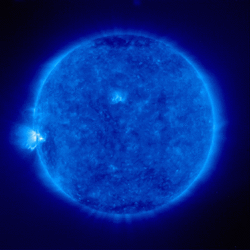
Image of the Sun taken by
EIT
onboard SOHO.
|
|
|
Solar system physics
|
|
Most rough surfaces exhibit an opposition effect,
strong brightening as the phase angle (the angle light
source - target - observer) goes to zero. Although there
are several theories and empirical models describing this
behaviour, the true cause is not yet completely
understood.
H. Karttunen has worked together with the Helsinki
Observatory group, mainly S. Kaasalainen and
J. Piironen, studying light scattering from solar
system objects and laboratory samples. Recently the work
has concentrated on scattering properties of snow and ice,
the results constituting a major part of Kaasalainen's
Ph.D. thesis, accepted in 2002. Although the measurement
procedure is simple in principle, there are some practical
problems, which may explain why only very few results have
been published. One problem is the heat radiating from the
devices and the observer; the heat tends to melt the
sample and change its crystal structure. Contaminated
snow seems to produce a stronger opposition effect than
pure snow. The effect of the crystal size still needs more
detailed measurements. The work will be continued next
winter.
|
|
|

|
